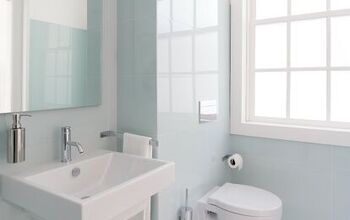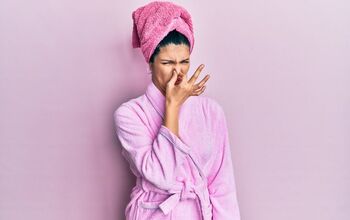Is There A Musty Smell In Your Bathroom? (Find Out Why)

Have you ever noticed a strange smell coming from your bathroom? Not a lingering stink from someone not using the Poo-pourri. The earthy, musty smell, most notable after you take a shower, flush the toilet, or reach under the bathroom sink.
If there’s a musty smell in your bathroom, it is most likely mildew, or worse, mold. Getting rid of this smell will require finding where it is coming from and cleaning the source. However, you may end up needing professional assistance if the mold growth has spread.
If the musty smell in the bathroom is mildew, you will want to address it quickly. Mildew is mold in its early stages, and leaving the smell unchecked will lead to bigger problems later. So, what is it you’re smelling–mildew or mold?
Do You Need to Hire a Plumber?
Get free, zero-commitment quotes from pro contractors near you.

Is The Musty Smell In Your Bathroom Mildew or Mold?
If this unwelcoming smell is coming from your bathroom, it may be mildew. Think of mildew as a biofilm of bacteria that grows mostly on flat surfaces. Bacteria, like everything else, is alive, and it’s probably what that wet, musty smell is.
If you’re not familiar with the scent, mildew can smell like wet socks over time. Many also describe the smell as rotting wood or wet paper.
Mildew can be white, tan, or grey and can look powdery in texture. You most commonly find this fluffy-looking growth on the walls of your shower or even under the sink.
If you find fuzzy mold with a particularly pungent odor, be mindful of the color. Mold can range in color from green to black. The color is an important part of identifying what type of mold you have.
Now that you know what to look for, you’ll need to know how to get rid of the mold. Then, you can banish that musty smell in the bathroom for good.
Getting Rid Of The Musty Smell In The Bathroom
Check for mold or mildew in places that water could be. Like the back of the toilet, under the sink, or in the corners of your shower.
Water that isn’t properly drained and is left to sit can become stagnant. Standing water such as this provides the perfect environment for mold and mildew growth to begin.
Mildew is easy enough to deal with. There are dozens of different products that you can purchase for removing mildew or mold. These cleaners will specify that they fight against mildew and mold, so finding one shouldn’t be too hard.
If you prefer a more natural method, you can also use household products like white vinegar and baking soda to tackle mildew. Proper ventilation is also key and keeping surfaces dry, like drying your shower after each use.
A Word Of Caution About Getting Rid Of Mold
You can use several products to kill mold, including alcohol. However, simply killing mold won’t necessarily rid you of its dangers. You also need to remove it. Even dead mold can still cause health problems.
Therefore, if the musty smell in your bathroom is mold, it’s worth calling in pros. If you want, you can purchase an at-home test kit first to verify you have mold. You can find these kits at any home-improvement store for about ten bucks.
Many of these kits offer the option to send your results to a lab for further analysis at an additional fee. This additional fee is roughly $40.
Are Mold And Mildew Dangerous?
Temperature can have a huge effect on mold. Mold flourishes in warm, humid environments with limited or no air circulation.
If you aren’t already aware of the danger that mold poses, here’s a refresher. Reactions to mold exposure can vary from person to person, depending on the amount of exposure.
People who are sensitive to mold can have reactions like an allergy flare-up. Mold exposure can cause itchy or red eyes and skin. Other symptoms can be wheezing, a stuffy nose, fever, and shortness of breath.
People with allergies are the most susceptible to complications caused by mold. Having a suppressed immune system or chronic lung condition can also put you at higher risk. A bad reaction to mold can be scary, and cleaning it is beneficial for both your home and your health.
Black Mold
At some point in your life, you’ve likely heard about the ominous “black mold.” However, what is black mold really?
Mold and black mold are types of fungi. Both mold and black mold can grow on household surfaces. Black mold is recognizable due to its black color and warrants prompt attention in comparison to other types of molds.
The difference between mold and black mold is that black mold may cause severe health problems. This is due to the mycotoxins they produce. In comparison, exposure to another type of mold may produce a less severe health complication.
Prolonged exposure to black mold can cause serious respiratory problems. Severe cases of exposure to black mold can even be fatal.
Other Types Of Mold
Black mold is only one of the five types of mold. The other types of mold are Alternaria, Aspergillus, Cladosporium, and Penicillium.
There are many similarities, and only a few differences, between regular mold and black mold. Regular mold doesn’t mean harmless, but it will have fewer adverse effects than black mold would. This is due to the lack of mycotoxins produced by other forms of mold.
Both types of fungi flourish on damp surfaces in common household mediums (drywall, wood, paper, etc.). Similarly, both molds will break apart and destroy the surfaces where they grow. Plus, they’ll both lead to the musty smell in your bathroom.
When Is There Too Much Mold To Handle?
Let’s say that in following your nose, you stumble across an advanced mold colony. Not mildew that just started inhibiting your home and raising a stink. A full-blown mold colony.
Small growths may have been left unchecked, and they began to multiply. This development causes the musty smell in the bathroom to just get worse over time. Eventually, you find it, the mold that has been growing right under your nose.
Even if you’re willing to clean it yourself, the situation may be beyond household remedies. Calling a professional to diagnose and fix your problem might be in your best interest.
Is There Mold In Or On Walls?
As an example, let’s say your bathroom sink has had a slow leak in its pipes. This leak could have gone on for several months or even years. So, what’s the big deal over this leaky sink?
A leak in the plumbing can allow water to get into the walls of your home. If mold grows in a wall, it can be extremely hard to stop it.
The dark enclosed area provided by the walls and insulation is the perfect breeding environment for these microorganisms. With just a little water, mildew will begin to grow, eventually turning into mold.
If left to grow for too long, mold growths can spread through the walls and to the foundation of the house. This spreading causes a lot more issues than a musty smell in the bathroom. Eventually, mold will rot away drywall, destroying both the interior and exterior of a home, making it uninhabitable to people.
When Is It Time To Call A Professional For A Musty Smell In The Bathroom?
If you believe there is mold growing in your walls, you need to call your local professional. This isn’t something to wait on either. The longer mold is allowed to spread, the more damage it can cause to your house and your overall health.
Extreme mold removal is best left to a specialist. They have the proper protective equipment to get the job done.
Some instances call for HazMat suits and respirators to protect the professional’s lungs. The protective gear will protect them from breathing in dangerous spores. These spores become airborne when professionals remove the mold.
Many companies deal specifically with water damage and mold remediation. A simple google search will pull up a list of your closest professionals equipped to help fix the problem.
Do You Need to Hire a Plumber?
Get free, zero-commitment quotes from pro contractors near you.

Related Questions
How can I tell if I have mold or just mildew?
Mildew grows on the surface and is usually white or gray and powdery in appearance. Mold will eventually eat away at whatever it’s growing on and can be many different colors. Where mildew appears powdery, mold appears fuzzy.
How do I prevent future mold and mildew growths?
You followed your nose to find that funky smell. You found the mold and cleaned it, but what if this is a problem spot? You will need to prevent future growth from happening.If you are not dealing with a significant mold growth problem, preventing future mold or mildew growths is manageable. Control the humidity as best as you can, making sure to ventilate your bathroom or problem area well. Helping to circulate the air will prevent water from hanging around long enough to grow mildew.
What are other health problems caused by black mold?
Prolonged mold exposure, and other moisture-driven organisms, can increase the risk of contracting rare conditions. Hypersensitivity pneumonitis, allergic alveolitis, chronic rhinosinusitis, and allergic fungal sinusitis are just a few examples.Hypersensitivity pneumonitis is a rare condition causing inflammation in the lungs due to the inhalation of harmful microorganisms.Similarly, allergic alveolitis is also a lung disorder resulting from repeatedly inhaling organic dust. This most frequently occurs because of a specific occupational setting, resulting in this occupational hazard. What’s different is the respiratory symptoms and fever begin hours after being exposed to the dust.Chronic rhinosinusitis is essentially a cold that lasts 12 weeks. It’s hard to deal with a cold for just a day or two. Imagine a cold lasting for three months.Finally, allergic fungal sinusitis is like a sinus infection caused by a fungus instead of the typical bacteria or viral culprits.Having mold in a home can pose a threat of causing a life-long condition. In some cases, mold can even be life-threatening. Be sure to address what that smell is as soon as possible to avoid any of these complications.

Stacy Randall is a wife, mother, and freelance writer from NOLA that has always had a love for DIY projects, home organization, and making spaces beautiful. Together with her husband, she has been spending the last several years lovingly renovating her grandparent's former home, making it their own and learning a lot about life along the way.
More by Stacy Randall



























